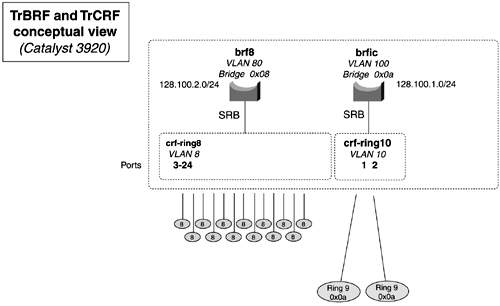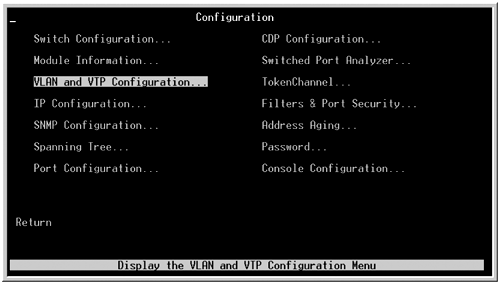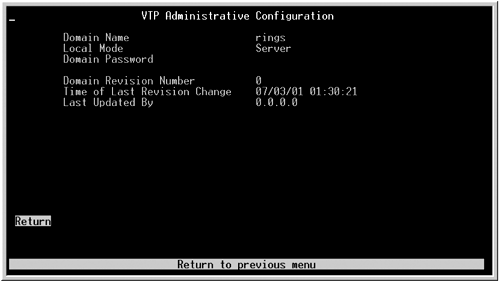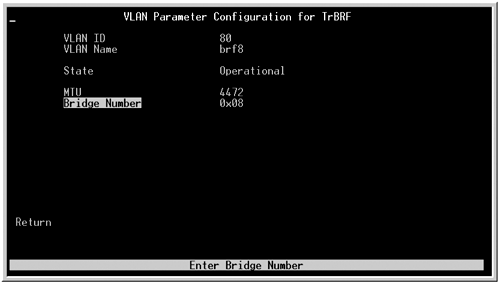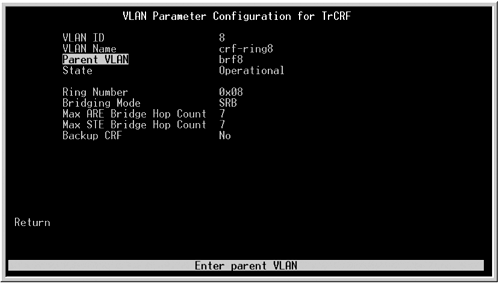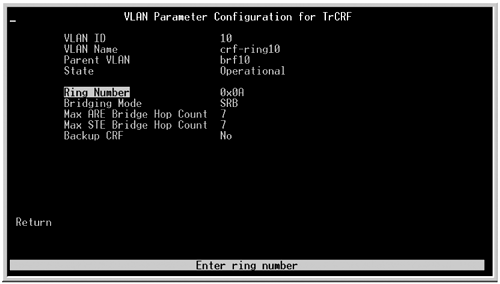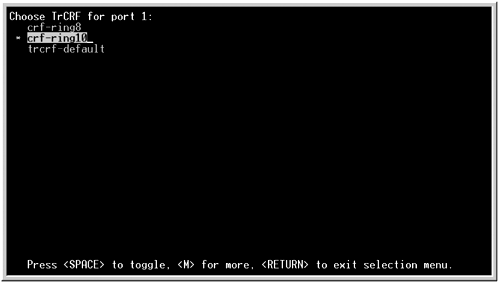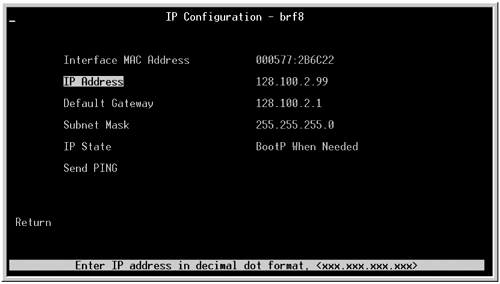Lab 8: Configuring Token Ring Switching Using the Catalyst 3920-Part II
| < Free Open Study > |
Lab 8: Configuring Token Ring Switching Using the Catalyst 3920 ”Part IILab WalkthroughAttach the routers to the switch with Cat 5 patch cables, as illustrated in Figure 2-41. When the physical hardware is properly attached, you can begin to follow the six steps for configuring Token Ring switching:
Figure 2-42 diagrams the VLANs that you will need to create. You will need to create two TrBRF VLANs and two TrCRF VLANs. Ports 3-24 will belong to TrCRF crf-ring8, with a parent TrBRF called brf8. Ports 1 and 2 will be in the TrCRF crf-ring10, with a parent TrBRF called brf10. Figure 2-42. TrBRF and TrCRF VLAN Conceptual Layout The switch configuration will be performed entirely from the configuration panel, of the main menu. Step 1 is to configure the VTP domain. Select the VLAN and VTP configuration panel. This is where you will configure VTP and the VLANs needed. Figure 2-43 displays the configuration panel. Figure 2-43. Configuration Panel From the VLAN and VTP configuration panel, select the VTP administrative configuration panel. Configure the VTP domain to be a server, and assign a name of rings to it. Figure 2-44 displays this panel. Figure 2-44. VTP Administrative Panel Step 3 involves configuring the TrBRFs. From the VLAN and VTP configuration panel, select the VTP VLAN configuration panel. From the VTP VLAN configuration panel select Add to add a new VLAN. The switch prompts you for a VLAN name. The first VLAN that you will create is brf8, VLAN 80. The switch then prompts you for whether the VLAN is a TrBRF or a TrCRF. When you select TrCRF, it takes you to the VLAN configuration menu. From this menu, name the VLAN brf8, and enter a ring number of 8. Remember to enter the ring number in hexadecimal format. Ring 10 will be entered as 0x0a when you configure that ring. Figures 2-45 and 2-46 display the VLAN configuration for TrBRFs. Figure 2-45. Detailed TrBRF VLAN Configuration Figure 2-46. Detailed TrBRF VLAN Configuration The next step in the configuration is to configure the TrCRF VLANs. These are created from the same menu as the TrBRF VLANs. When you are prompted for the VLAN type, you obviously should select TrCRF instead of TrBRF. When creating the TrCRF VLANs, do not get the VLAN IDs confused . The VLAN IDs for the TrCRF and TrBRFs are unique. The TrCRF is linked to a TrBRF by making it a parent to TrCRF, not by the VLAN ID. Figures 2-47 and 2-48 display the configuration of the TrCRFs VLANs. Figure 2-47. Detailed TrCRF VLAN Configuration Figure 2-48. Detailed TrCRF VLAN Configuration Figure 2-49 displays the VTP VLAN configuration panel with the newly created VLANs. Figure 2-49. VLAN Listing Step 5 involves assigning the ports to the TrCRFs just created. Ports 3 to 24 will be assigned to TrCRF crf-ring8, and ports 1 and 2 will be assigned to TrCRF crf-ring10. From the VLAN VTP configuration panel, select the Local VLAN port configuration option. From this panel, select the port that you want to modify. When the port is selected, the switch prompts you for what TrCRFs are available to attach the port to. Figure 2-50 displays this option. Figure 2-50. Port Configuration The final step in the configuration is to configure IP access. From the main configuration panel, select IP Configuration to configure an IP address. When this panel is selected, the switch prompts you for a TrBRF to attach the IP address to. In this model, the IP address is 128.100.2.99, so it will attach to TrBRF brf8. When in this menu, enter the IP information; use 128.100.2.1 for the default gateway. Figure 2-51 displays the IP configuration panel. Figure 2-51. IP Configuration The IP interface will not become active until the same TrBRF becomes the default management interface. This is enabled through the SNMP configuration panel. From the SNMP configuration panel, change the management VLAN from the default to TrBRF brf8. The switches are fully operational now, and the routers can be configured. The router portion of the lab is rather straightforward. The doom1 router will have two Token Ring interfaces and will run RIP for a routing protocol. The doom2 router will need only one interface configured for IP. Example 2-66 illustrates the relevant configuration of the doom1 and doom2 routers. Example 2-66 Configurations of the doom1 and doom2 Routershostname doom1 ! <<<text omitted>>> ! interface TokenRing0 ip address 128.100.1.1 255.255.255.0 no ip directed-broadcast ring-speed 16 ! interface TokenRing1 ip address 128.100.2.1 255.255.255.0 no ip directed-broadcast ring-speed 16 ! router rip network 128.100.0.0 ! __________________________________________________________ ! ! hostname doom2 ! <<<text omitted>>> ! interface TokenRing0 ip address 128.100.1.3 255.255.255.0 ring-speed 16 ! interface BRI0 no ip address shutdown ! router rip network 128.100.0.0 ! When the routers are configured, test the network by ping ing all router and switch interfaces. The route table of the doom2 router also shows the subnet 128.100.2.0/24 being reported by RIP. |
| < Free Open Study > |
EAN: 2147483647
Pages: 283
